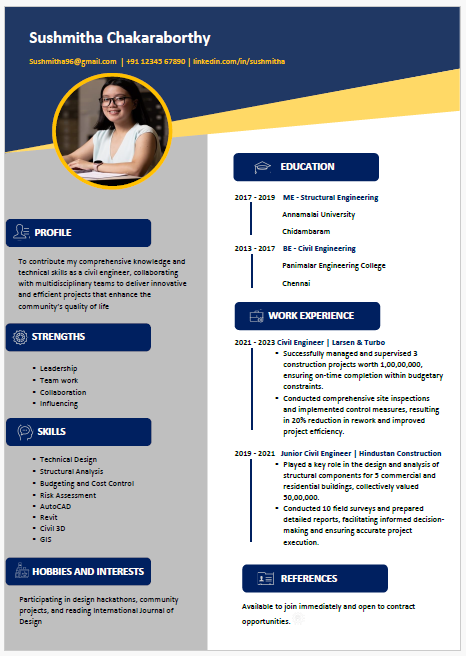Structure Engineer
ME - Structural Engineering

About this template
This is a well-designed resume which can make a significant difference in capturing the attention of hiring managers and landing your dream job.
This is a very colorful and modern resume which can help you stand out from the competition. Its vibrant design and well-organized layout effectively showcase your skills and achievements, making a lasting impression on potential employers.
Some important and useful technical skills for structure engineer
Structural engineers need a diverse set of technical skills to design and analyze structures that are safe, functional, and cost-effective. Here are ten important and useful technical skills for structural engineers:
1. Structural Analysis:
Proficiency in structural analysis is essential for understanding how different forces affect structures. Structural engineers use software like SAP2000, ETABS, and STAAD.Pro to model and analyze load-bearing elements, ensuring that structures can withstand various loads and stresses.
2. Design of Structural Elements:
Expertise in designing structural components such as beams, columns, and foundations is crucial. Structural engineers must apply principles of mechanics and material science to ensure that each element is capable of supporting the required loads while maintaining structural integrity.
3. Knowledge of Building Codes and Standards:
Understanding building codes and industry standards is vital for ensuring compliance and safety. Structural engineers must be familiar with local and international codes, such as the International Building Code (IBC) and Eurocodes, to ensure that designs meet legal and safety requirements.
4. Material Science:
Knowledge of material science helps structural engineers select appropriate materials for different structural elements. Understanding the properties of materials like concrete, steel, and timber allows engineers to make informed decisions about their use in construction projects.
5. Finite Element Analysis (FEA):
Proficiency in Finite Element Analysis (FEA) is crucial for modeling complex structures and analyzing stress distribution. Engineers use FEA software to simulate real-world conditions and evaluate how structures behave under various loading scenarios.
6. Seismic Design and Analysis:
Skills in seismic design are important for creating structures that can withstand earthquakes. Structural engineers must understand seismic loads, base isolation techniques, and lateral force distribution to ensure structures remain safe during seismic events.
7. Computer-Aided Design (CAD):
Mastery of CAD software like AutoCAD and Revit is essential for creating detailed structural drawings and plans. CAD tools enable structural engineers to produce accurate, detailed designs and collaborate effectively with other professionals.
8. Building Information Modeling (BIM):
Expertise in BIM is increasingly important for modern structural engineering. BIM software, such as Revit and Navisworks, helps engineers create digital models of structures, allowing for better visualization, coordination, and management of complex projects.
9. Structural Dynamics:
Understanding structural dynamics is crucial for analyzing how structures respond to dynamic loads, such as wind or traffic. Structural engineers use dynamic analysis techniques to ensure that structures can handle varying load conditions and vibrations.
10. Construction Methods and Techniques:
Knowledge of construction methods and techniques is important for ensuring that designs can be practically implemented. Structural engineers must understand various construction practices and material handling to collaborate effectively with contractors and ensure successful project execution.
Conclusion:
These technical skills enable structural engineers to design, analyze, and oversee the construction of safe and reliable structures, ensuring they meet both functional and regulatory requirements.